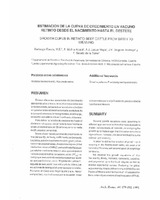Mostrar el registro sencillo del ítem
Estimación de la curva de crecimiento en vacuno retinto desde el nacimiento hasta el destete
| dc.contributor.author | Luque Moya, A.J. | es_ES |
| dc.contributor.author | Berlanga García, M.E. | es_ES |
| dc.contributor.author | Molina Alcalá, Antonio | es_ES |
| dc.contributor.author | Salado de la Torre, F. | es_ES |
| dc.contributor.author | Delgado-Bermejo, J.V. | |
| dc.date.accessioned | 2010-05-18T09:25:54Z | |
| dc.date.available | 2010-05-18T09:25:54Z | |
| dc.date.issued | 1995 | |
| dc.identifier.issn | 1885-4494 | |
| dc.identifier.uri | http://hdl.handle.net/10396/3342 | |
| dc.description.abstract | Several growth equations exist according to different approaches of authors that have studied this matter, but practically all coincide, on analyzing the growth up to mature age, that the curve acquires a sigmoid form; however, it is assumed that this curve is lineal upto weaning. In order to define the function of growth up to weaning in the Retinta beef cattle, we used a lot formed by 35 calves, with an average of 28 weightings per animal. We studied the growth equations of Von Bertalanffy, Brody, Richards, Gompertz, Logistics, and polynomial up to the fourth degree as well as diverse exponential curves. Analyzing the global adjustment by means of the minimum SRM (Square Residual Means) and the maximum R2 adjusted for the number of parameters of each equation (R2Adj), it was deduced that the better adjustment growth equation is the lineal equation with a R2 global of 0.903671. Therefore, based on their better adjustment and their minor complexity, we support the lineal equation as the model for the weight adjustment to fixed ages up to the weaning. | en |
| dc.description.abstract | Existen diferentes ecuaciones de crecimiento atendiendo a los criterios de los distintos autores que lo han estudiado, pero prácticamente todos coinciden en que al analizar el crecimiento hasta la edad adulta la curva adquiere una forma sigmoidea, sin embargo, se asume que esta curva es lineal hasta el destete. Para definir la función de crecimiento hasta el destete en el vacuno de carne de la raza Retinta se utilizó un lote formado por 35 terneros, con una media de 28 pesadas por animal. Se estudiaron las ecuaciones de crecimiento de Von Bertalanffy, de Brody, de Richards, de Gompertz, Logística, polinómicas hasta el cuarto grado y diversas curvas exponenciales. Analizando el ajuste global mediante el mínimo CMR (Cuadrado Medio Residual) y el máximo coeficiente determinativo ajustado para el número de parámetros de cada ecuación (R2Mj), se dedujo que la ecuación de crecimiento de mejor ajuste es la ecuación lineal con un R2 global de 0,903671, seguida de la ecuación cuadrática y de la cúbica. Las ecuaciones de peor ajuste fueron las exponenciales. Por tanto, en base a su mejor ajuste y a su menor complejidad, nos inclinamos por la ecuación lineal como modelo para la tipificación de pesos a edades fijas hasta el destete. | es_ES |
| dc.format.mimetype | application/pdf | es_ES |
| dc.language.iso | spa | es_ES |
| dc.publisher | Universidad de Córdoba, Servicio de Publicaciones | es_ES |
| dc.rights | https://creativecommons.org/licenses/by-nc-nd/4.0/ | es_ES |
| dc.source | Archivos de zootecnia 44 (166-167), 179-192 (1995) | es_ES |
| dc.subject | Vacuno retinto | es_ES |
| dc.subject | Modelos de crecimiento | es_ES |
| dc.subject | Vacuno de carne | es_ES |
| dc.subject | Valoración al destete | es_ES |
| dc.title | Estimación de la curva de crecimiento en vacuno retinto desde el nacimiento hasta el destete | es_ES |
| dc.title.alternative | Growth curve in retinto beef cattle from birth to weaning | en |
| dc.type | info:eu-repo/semantics/article | es_ES |
| dc.relation.publisherversion | http://www.uco.es/organiza/servicios/publica/az/az.htm | es_ES |
| dc.rights.accessRights | info:eu-repo/semantics/openAccess | es_ES |

